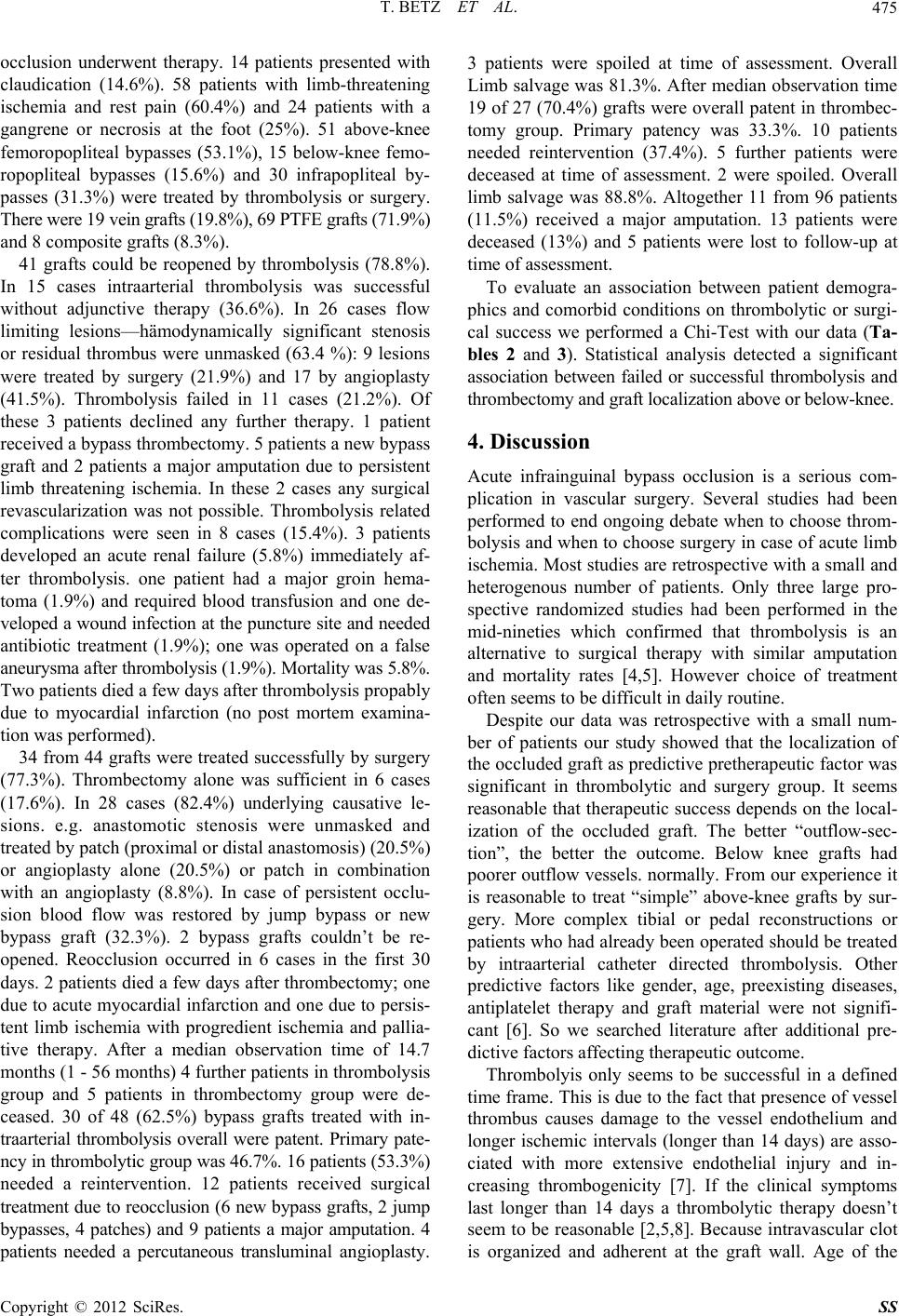
T. BETZ ET AL. 475
occlusion underwent therapy. 14 patients presented with
claudication (14.6%). 58 patients with limb-threatening
ischemia and rest pain (60.4%) and 24 patients with a
gangrene or necrosis at the foot (25%). 51 above-knee
femoropopliteal bypasses (53.1%), 15 below-knee femo-
ropopliteal bypasses (15.6%) and 30 infrapopliteal by-
passes (31.3%) were treated by thrombolysis or surgery.
There were 19 vein grafts (19.8%), 69 PTFE grafts (71.9%)
and 8 composite grafts (8.3%).
41 grafts could be reopened by thrombolysis (78.8%).
In 15 cases intraarterial thrombolysis was successful
without adjunctive therapy (36.6%). In 26 cases flow
limiting lesions—hämodynamically significant stenosis
or residual thrombus were unmasked (63.4 %): 9 lesions
were treated by surgery (21.9%) and 17 by angioplasty
(41.5%). Thrombolysis failed in 11 cases (21.2%). Of
these 3 patients declined any further therapy. 1 patient
received a bypass thrombectomy. 5 patients a new bypass
graft and 2 patients a major amputation due to persistent
limb threatening ischemia. In these 2 cases any surgical
revascularization was not possible. Thrombolysis related
complications were seen in 8 cases (15.4%). 3 patients
developed an acute renal failure (5.8%) immediately af-
ter thrombolysis. one patient had a major groin hema-
toma (1.9%) and required blood transfusion and one de-
veloped a wound infection at the puncture site and needed
antibiotic treatment (1.9%); one was operated on a false
aneurysma after thrombolysis (1.9%). Mortality was 5.8%.
Two patients died a few days after thrombolysis propably
due to myocardial infarction (no post mortem examina-
tion was perform e d) .
34 from 44 grafts were treated successfully by surgery
(77.3%). Thrombectomy alone was sufficient in 6 cases
(17.6%). In 28 cases (82.4%) underlying causative le-
sions. e.g. anastomotic stenosis were unmasked and
treated by patch (proximal or distal anastomosis) (20.5%)
or angioplasty alone (20.5%) or patch in combination
with an angioplasty (8.8%). In case of persistent occlu-
sion blood flow was restored by jump bypass or new
bypass graft (32.3%). 2 bypass grafts couldn’t be re-
opened. Reocclusion occurred in 6 cases in the first 30
days. 2 patients died a few days after thrombectomy; one
due to acute myocardial infarction and one due to persis-
tent limb ischemia with progredient ischemia and pallia-
tive therapy. After a median observation time of 14.7
months (1 - 56 months) 4 further patients in thrombolysis
group and 5 patients in thrombectomy group were de-
ceased. 30 of 48 (62.5%) bypass grafts treated with in-
traarterial thrombolysis overall were patent. Primary pate-
ncy in thrombolytic group was 46.7%. 16 patients (53.3%)
needed a reintervention. 12 patients received surgical
treatment due to reocclusion (6 new bypass grafts, 2 jump
bypasses, 4 patches) and 9 patients a major amputation. 4
patients needed a percutaneous transluminal angioplasty.
3 patients were spoiled at time of assessment. Overall
Limb salvage was 81.3%. After median observation time
19 of 27 (70.4%) grafts were overall paten t in thrombec-
tomy group. Primary patency was 33.3%. 10 patients
needed reintervention (37.4%). 5 further patients were
deceased at time of assessment. 2 were spoiled. Overall
limb salvage was 88.8%. Altogether 11 from 96 patients
(11.5%) received a major amputation. 13 patients were
deceased (13%) and 5 patients were lost to follow-up at
time of assessment.
To evaluate an association between patient demogra-
phics and comorbid conditions on thrombolytic or surgi-
cal success we performed a Chi-Test with our data (Ta-
bles 2 and 3). Statistical analysis detected a significant
association between failed or successful thrombolysis and
thrombectomy and graft localization above or below-knee.
4. Discussion
Acute infrainguinal bypass occlusion is a serious com-
plication in vascular surgery. Several studies had been
performed to end ongoing debate when to choose throm-
bolysis and when to choose surgery in case of acute limb
ischemia. Most studies are retrospective with a small and
heterogenous number of patients. Only three large pro-
spective randomized studies had been performed in the
mid-nineties which confirmed that thrombolysis is an
alternative to surgical therapy with similar amputation
and mortality rates [4,5]. However choice of treatment
often seems to be difficult in daily routine.
Despite our data was retrospective with a small num-
ber of patients our study showed that the localization of
the occluded graft as predictive pretherapeutic factor was
significant in thrombolytic and surgery group. It seems
reasonable that therapeutic success depends on the local-
ization of the occluded graft. The better “outflow-sec-
tion”, the better the outcome. Below knee grafts had
poorer outflow v essels. normally. From our experience it
is reasonable to treat “simple” above-knee grafts by sur-
gery. More complex tibial or pedal reconstructions or
patients who had already been operated should be treated
by intraarterial catheter directed thrombolysis. Other
predictive factors like gender, age, preexisting diseases,
antiplatelet therapy and graft material were not signifi-
cant [6]. So we searched literature after additional pre-
dictive factors affecting therapeutic outcome.
Thrombolyis only seems to be successful in a defined
time frame. This is due to the fact that presence of vessel
thrombus causes damage to the vessel endothelium and
longer ischemic intervals (longer than 14 days) are asso-
ciated with more extensive endothelial injury and in-
creasing thrombogenicity [7]. If the clinical symptoms
last longer than 14 days a thrombolytic therapy doesn’t
seem to be reasonable [2,5,8]. Because intravascular clot
is organized and adherent at the graft wall. Age of the
Copyright © 2012 SciRes. SS